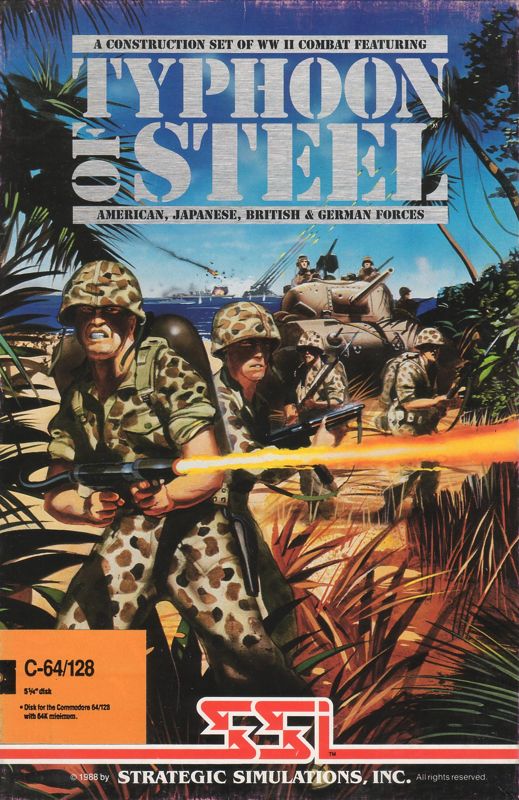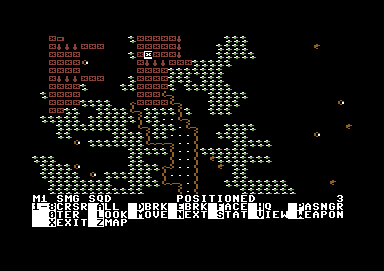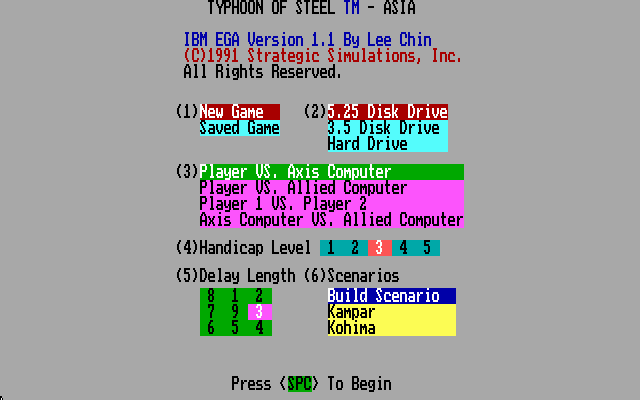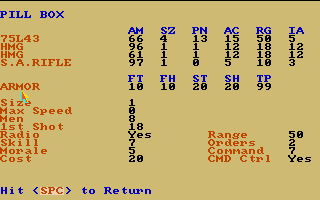Retro Replay Review
Gameplay
Typhoon of Steel thrusts players into intense tactical-level skirmishes, offering a deep simulation of small unit actions across three distinct WWII theaters. The game’s mechanics mirror its predecessor, Panzer Strike, with familiar hex-based movement, line-of-sight rules, and an emphasis on realistic weapon ranges and ballistic effects. Whether maneuvering Sherman tanks in Europe or coordinating infantry squads with support guns in the Pacific, you’ll find yourself balancing firepower, cover and morale at every turn.
One of the game’s standout features is the sheer variety of units at your disposal. With over 220 weapon types ranging from Japanese infantry rifles to German Tiger I tanks and American bazookas, Typhoon of Steel allows you to tailor your force composition to each scenario. The logistics layer in campaign mode forces you to plan ahead—losses in one battle affect your force quality in subsequent engagements, making every decision critical to long-term success.
The single-battle mode caters to both solo and head-to-head play, offering fast-paced engagements that can last anywhere from thirty minutes to two hours. Meanwhile, the campaign mode delivers a marathon experience that can span up to thirty hours of gameplay. Seasoned strategy gamers will relish the advanced ruleset, but newcomers may find the learning curve steep. Still, those willing to invest time will discover an addictive flow that rewards careful planning and tactical creativity.
Graphics
While Typhoon of Steel isn’t pushing the technological envelope by modern standards, its graphical presentation remains serviceable for a game focused on simulation accuracy. Hexagonal grids, unit icons and terrain features are clearly rendered, ensuring you can read the battlefield at a glance. Scenery such as jungle foliage in the Asian Theater or European farmlands is detailed enough to enhance immersion without distracting from the core tactical decisions.
The game uses a consistent color palette to denote different terrain types—greens for forested areas, browns for open ground, blues for water obstacles—which helps with quick strategic assessments. Unit counters display small yet recognizable silhouettes of tanks, guns and infantry squads, and the user interface provides accessible tooltips and status bars outlining health, ammunition and morale. Animations for movement and combat are minimal but effective, with a satisfying explosion effect when a tank is knocked out or an artillery barrage lands.
In campaign mode, the strategic map adopts a higher-level view of your theaters of operation. Cities, supply lines and reinforcement pools are marked clearly, enabling you to plan future offensives or consolidate your defenses. Though the visuals lack flashy 3D models or dynamic lighting, the clarity and functionality of the presentation align perfectly with the game’s simulation ethos and allow you to focus on the tactical puzzle.
Story
Typhoon of Steel does not present a traditional narrative with scripted events or character arcs; instead, the “story” emerges organically from the outcomes of your battles. Each theater—Pacific, Asia and Europe—features historically grounded orders of battle and scenario briefings that set the stage for your operations. Detailed historical notes provide context on unit capabilities, terrain challenges and the strategic stakes of the conflict.
As you progress through a campaign, the ebb and flow of war creates its own narrative. Triumphs in early engagements can propel your forces into key offensive operations, while setbacks force you to regroup and defend critical positions. Over time, your personal record of losses, reinforcements and captured objectives becomes a bespoke chronicle of a soldier’s or commander’s wartime journey.
This emergent storytelling approach encourages replayability, since different decisions and random combat events yield fresh challenges and outcomes. While die-hard history buffs will appreciate the attention to period detail, gamers seeking a tightly written plot with cutscenes or dialogue may find the story lean. Nonetheless, the authentic WWII flavor and scenario-driven briefings make each battle feel like a chapter in a larger, high-stakes conflict.
Overall Experience
Typhoon of Steel shines as a deep, uncompromising tactical simulation. It requires patience to master the complex rules and unit interactions, but the reward is a richly detailed battlefield sandbox that offers near-endless strategic possibilities. Veteran wargamers will find the advanced mechanics and historical scope immensely satisfying, while newcomers willing to learn will discover a treasure trove of WWII tactical challenges.
The pacing can feel deliberate, especially in lengthy campaign sessions, but this reflects the reality of battlefield decision-making rather than a flaw in design. The balance between single battles and extended campaigns suits a variety of playstyles: jump into a quick skirmish with a friend, or settle in for multi-hour operations that test your logistical acumen as much as your tactical instincts.
Although the graphics and lack of narrative scripting may feel dated by modern standards, Typhoon of Steel’s strength lies in its simulation fidelity and the palpable tension of small unit warfare. If you crave a hardcore WWII tactics experience that places historical authenticity and strategic depth front and center, this sequel to Panzer Strike delivers in spades—offering dozens of hours of engrossing gameplay across three major theaters of war.
 Retro Replay Retro Replay gaming reviews, news, emulation, geek stuff and more!
Retro Replay Retro Replay gaming reviews, news, emulation, geek stuff and more!









Reviews
There are no reviews yet.